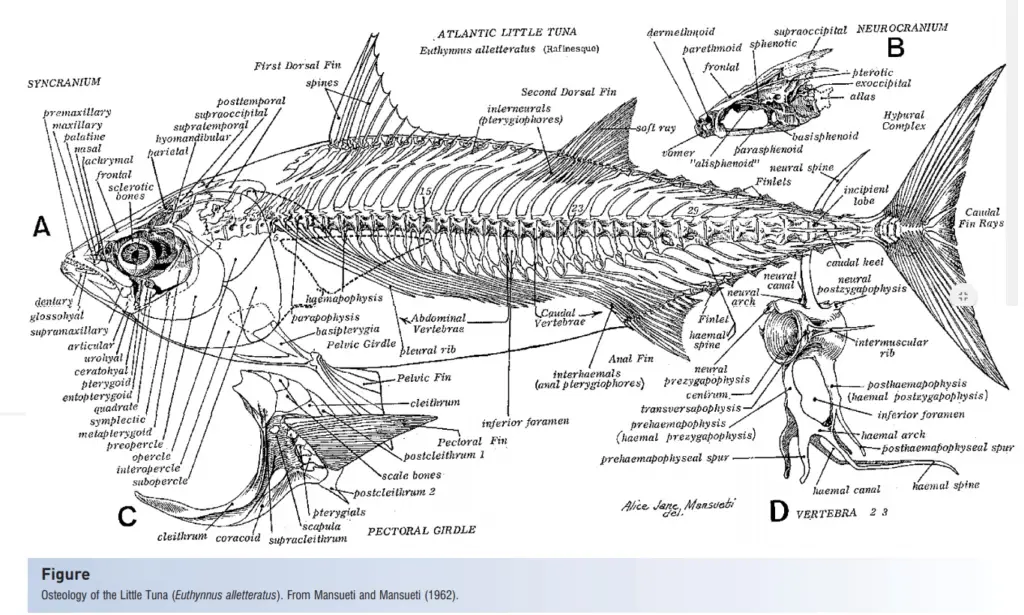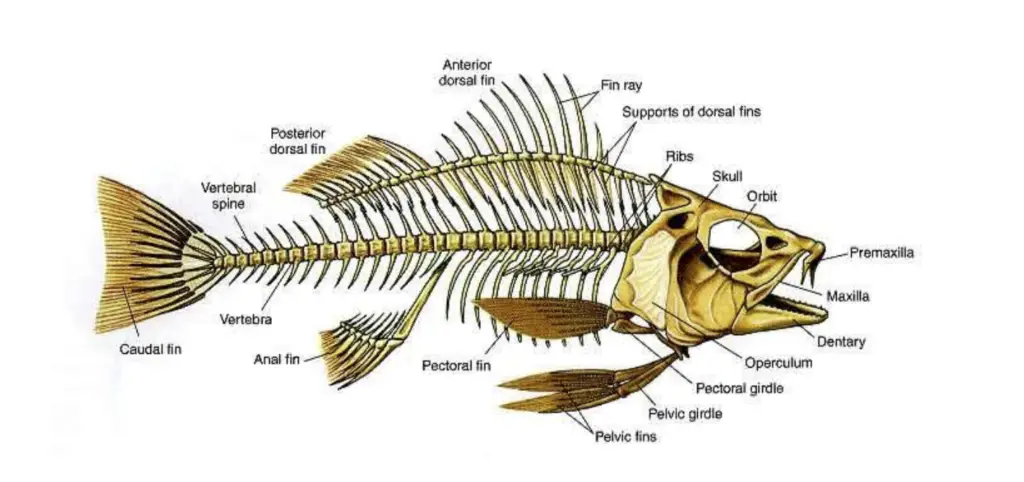- The skeletal structure of fish plays a crucial role in maintaining the integrity and functionality of these aquatic vertebrates. Fish are classified under the superclass Pisces and encompass a diverse range of species, each with a unique skeletal composition. The skeletal system serves as the foundational framework that supports the body, providing not only protection and shape but also facilitating locomotion.
- The skeletal system of fish can be broadly categorized into two types: bony and cartilaginous. Bony fish, which include the majority of fish species, possess a skeleton primarily made of bones. This bony structure consists of various components such as the vertebrae, skull, ribs, and fin supports. In contrast, cartilaginous fish, such as sharks and rays, have a skeleton predominantly composed of cartilage. Cartilage is a flexible connective tissue that is lighter than bone, allowing for increased buoyancy and agility in these species. This distinction highlights the evolutionary adaptations that allow different fish types to thrive in their respective environments.
- The primary functions of the skeletal system in fish are multifaceted. First and foremost, it provides structural support, enabling fish to maintain their shape and resist external pressures encountered in aquatic environments. Furthermore, the skeletal system protects vital organs, such as the brain and heart, housed within the skull and thoracic cavity, respectively. Additionally, the skeletal structure plays an essential role in locomotion. The arrangement of bones and cartilage allows for the articulation of fins and the effective movement of the tail, facilitating swimming and maneuvering through water.
- Moreover, the skeletal system is not solely about support and protection; it also plays a significant role in the overall physiology of fish. The bones in bony fish serve as a reservoir for minerals, particularly calcium and phosphorus, which are vital for various bodily functions. Cartilage in cartilaginous fish contains specialized cells that contribute to growth and repair, ensuring the continued health of the skeletal structure.

Classification of Fish Based on the Habitat and Skeletal System
The classification of fish is primarily based on two factors: the type of skeletal system and their habitat. This categorization facilitates a deeper understanding of their biological and ecological adaptations.
- Cartilaginous Fishes (Chondrichthyes):
- Skeletal Composition: The skeleton of cartilaginous fishes is primarily composed of cartilage, which is lightweight and flexible. This structural composition allows for rapid and efficient movement in aquatic environments.
- Durability: Despite being less rigid than bone, cartilage provides significant durability, thereby offering protection to internal organs.
- Buoyancy Mechanisms: These fishes lack bone marrow and do not possess a swim bladder, which is commonly found in bony fishes. Instead, they rely on an oil-filled liver, which is dense and aids in maintaining buoyancy in water.
- Habitat: Cartilaginous fishes are predominantly found in saltwater environments, including oceans. Examples include sharks, rays, and skates, which have adapted to various niches within these ecosystems.
- Bony Fishes (Osteichthyes):
- Skeletal Composition: Bony fishes are characterized by a skeleton composed of hard, calcified bones. This rigid structure provides substantial support and protection for the body, enabling fish to withstand various environmental pressures.
- Muscle Attachment: The bony framework serves as an anchor for muscular attachments, allowing for powerful swimming motions that facilitate their movement and survival.
- Buoyancy Regulation: Bony fishes possess a swim bladder, a gas-filled organ that helps regulate buoyancy and enables these fish to maintain their position in the water column without expending energy.
- Habitat Diversity: This group includes a wide range of species that exhibit various adaptations based on their specific habitats, which can include freshwater, brackish, and saltwater environments. Examples include trout, salmon, and goldfish, each of which has adapted to thrive in its unique ecological niche.
Structure of the Fish Skeleton System
The composition of the fish skeleton system is intricate and essential for understanding the structural and functional adaptations of these aquatic vertebrates. Comprising approximately 150 bones, the fish skeletal system can be categorized into two primary components: the endoskeleton and the exoskeleton. Each part plays a vital role in supporting the fish’s body, facilitating movement, and protecting vital organs.
- The Endoskeleton:
- Structure: This internal framework includes the skull, vertebrae, and ribs, providing support and protection to the internal structures of the fish.
- Skull: The fish skull consists of a double-layered structure with two boxes of bone; the outer box is composed of dermal bones, which serve as armor in primitive bony fishes. In modern fish, the inner skull is formed of approximately 130 small, loosely connected bones and is subdivided into three parts:
- Chondrocranium: Present in cartilaginous fishes like sharks and rays, this cartilaginous structure is replaced by neurocranium, an endochondral bone, in bony fishes.
- Splanchnocranium: Known as the visceral skeleton, this part is formed by the branchial arches or gill arches. It supports the oral cavity, including the teeth and jaws, enhancing feeding capabilities.
- Dermatocranium: Composed of dermal bones, this major part of the skull provides protection for the brain and includes roofing bones, palatal bones, and jaw bones.
- Vertebral Column: A series of endochondral bones, known as vertebrae, form the vertebral column. Each vertebra features a central spool-shaped structure called the centrum, with a canal for the notochord. The vertebral column comprises:
- Trunk Region: Lacking a neck, the first two trunk vertebrae are modified and do not possess ribs, while the remaining vertebrae include ribs that protect the thoracic cavity.
- Caudal Region: In the tail section, the vertebrae contain a ventral portion that forms a hemal arch, safeguarding the blood vessels.
- The Exoskeleton:
- Functionality: This external framework primarily supports the fins of the fish, enhancing mobility and stability in water.
- Median Fins: The dorsal fins consist of fin rays, with the anterior dorsal fin featuring ossified (hardened) fin rays providing stiff support. In contrast, the posterior dorsal fin is characterized by soft, unossified rays. The anal fin contains the first two ossified fin rays, while the caudal fin is made up entirely of soft fin rays.
- Pectoral Girdle and Fins: The pectoral girdle, which supports the pectoral fins, consists of several fused elements and is directly fused to the skull, facilitating maneuverability and stabilization during swimming. The fins themselves are supported by soft fin rays.
- Pelvic Girdle and Fins: The pelvic fins attach to the pelvic girdle, which comprises two bony pelvic plates fused along the midline. Unlike the pectoral girdle, the pelvic girdle is not directly connected to the vertebral column; instead, it is embedded within the surrounding muscle tissue, allowing for greater flexibility.
Bones of Fish

The bones of fish represent a specialized and intricate skeletal system that serves essential functions in supporting the body, facilitating movement, and protecting internal structures. Fish skeletal systems comprise various types of bones, each with distinct roles that contribute to the overall anatomy and functionality of these aquatic organisms.
- Vomer: This midline bone is situated on the roof of the mouth and primarily supports the teeth. It plays a critical role in maintaining the structural integrity of the oral cavity during feeding.
- Articular: Composed of a pair of angular-shaped bones, the articular forms a movable joint at the posterior end of the lower jaw. This joint is essential for the movement of the jaw, allowing for effective feeding and prey capture.
- Maxillary: These paired bones fuse with the palatal fissure to form the upper jaw. Their structural arrangement contributes to the overall shape and function of the mouth, aiding in the capture and processing of food.
- Retro Articular: Located at the lower posterior corner of the articular, these paired bones provide additional support and stability to the lower jaw, facilitating efficient movement during feeding.
- Opercle: This paired, flat bone connects to the hyomandibula bones, forming the majority of the gill cover. The opercle plays a significant role in protecting the gills and assisting in respiration by regulating water flow over the gill structures.
- Centrum: The centrum is the central cylindrical component of each vertebra. It obstructs the embryonic notochord during the ossification process, serving as a crucial structural element that provides support along the length of the vertebral column.
- Dentary: Comprising large paired dental bones that unite medially, the dentary forms the front portion of the lower jaw. This structure is critical for grasping and processing food, significantly impacting the feeding behavior of fish.
- Scapula: The scapula consists of a pair of flat bones that articulate with the coracoids anteriorly and the cleithra posteriorly. These bones provide support for the pectoral girdle, which is essential for fin movement. Additionally, small bones called radials connect the fin rays that articulate with the scapula and coracoid bones, facilitating coordinated swimming motions.
Fish Skeletal System Functions
The skeletal system of fish performs a multitude of essential functions that are crucial for their survival and adaptation in aquatic environments. Understanding these functions provides insight into how fish navigate their habitats effectively.
- Support and Structure: The skeletal system serves as a foundational framework that offers physical support and shape to the fish’s body. This structural integrity is vital for maintaining the overall form of the fish, enabling it to withstand various external pressures encountered in the aquatic environment.
- Protection of Vital Organs: The skeletal system acts as a protective barrier for critical internal organs. For instance, the skull encases the brain and sensory organs, safeguarding them from external threats. Additionally, the ribs and vertebrae form a protective cage that shields vital organs such as the heart, lungs, and swim bladder from environmental pressures and potential harm.
- Locomotion: A primary function of the skeletal system is to facilitate movement. The fins, supported by skeletal structures, act as propellers that enable stability, steering, and propulsion through water. The interaction between muscles and bones allows fish to swim efficiently, conserving energy while navigating their surroundings and evading predators. The type of skeletal support—whether rigid bones or flexible cartilage—depends on the specific fish species and its mode of locomotion.
- Buoyancy Control: Buoyancy is crucial for maintaining depth in the water column with minimal energy expenditure. In bony fish, the swim bladder plays a significant role in buoyancy regulation. This gas-filled organ enables fish to control their position in the water, aiding in equilibrium and allowing for effortless vertical movement.
- https://www.geeksforgeeks.org/skeletal-system-of-fish/
- https://byjus.com/biology/fish-skeletal-system/
- https://www.brainkart.com/article/Skeleton-of-Fishes_22030/
- https://www.vedantu.com/biology/fish-skeletal-system
- http://courseware.cutm.ac.in/wp-content/uploads/2020/05/Session-14-Skeletal-System.pdf
- https://www.slideshare.net/JubayrAl/skeleton-of-fishes
- https://www.stevenpoe.net/uploads/3/7/3/4/37343605/lab_2_-_skeletons_and_locomotion.pdf
- https://acikders.ankara.edu.tr/mod/resource/view.php?id=143379
- https://seaworld.org/animals/all-about/bony-fish/anatomy-and-physiology/
- Text Highlighting: Select any text in the post content to highlight it
- Text Annotation: Select text and add comments with annotations
- Comment Management: Edit or delete your own comments
- Highlight Management: Remove your own highlights
How to use: Simply select any text in the post content above, and you'll see annotation options. Login here or create an account to get started.